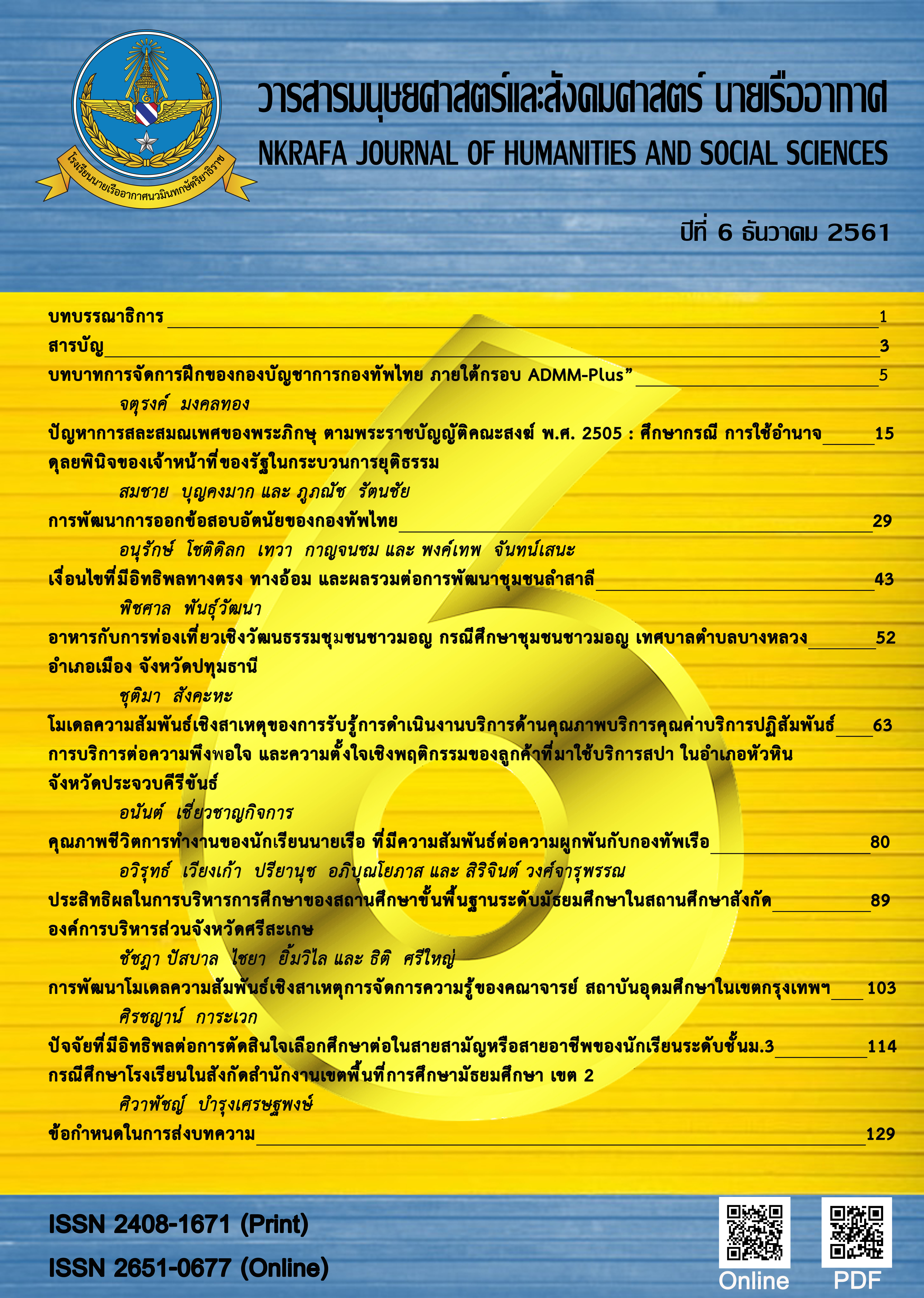เงื่อนไขที่มีอิทธิพลทางตรง ทางอ้อม และผลรวมต่อการพัฒนาชุมชนลำสาลี
Main Article Content
บทคัดย่อ
บทคัดย่อ
การวิจัยมีวัตถุประสงค์เพื่อศึกษา 1) สภาพทั่วไปของบุคคลที่อาศัยในชุมชนลำสาลี และ 2) อิทธิพลของปัจจัยพื้นฐานทางเศรษฐกิจ ผู้นำการเปลี่ยนแปลง การเมืองการปกครอง และบุคคลในชุมชนที่มีต่อการพัฒนาชุมชนลำสาลี ใช้ระเบียบวิธีการวิจัย 2 แนวทาง เชิงปริมาณใช้แบบสอบถามเก็บข้อมูลจากบุคคลที่อาศัยในชุมชนลำสาลีจำนวน 129 ราย วิเคราะห์ข้อมูลด้วยเทคนิคการวิเคราะห์เส้นทางและสถิติพรรณนา เชิงคุณภาพเก็บข้อมูลจากการสัมภาษณ์เจาะลึก การสังเกตแบบมีโครงสร้าง และการบันทึกสนามกับบุคคลที่อาศัยในชุมชนลำสาลี จำนวน 14 ราย ผลการวิจัยที่สำคัญพบว่า บุคคลในชุมชนเป็นเงื่อนไขที่มีอิทธิพลทางตรงต่อการพัฒนาชุมชนมากที่สุด และปัจจัยด้านพื้นฐานเศรษฐกิจเป็นเงื่อนไขที่มีอิทธิพลทางอ้อมและอิทธิพลผลรวมต่อการพัฒนาชุมชนมากที่สุด
Article Details
บทความที่ได้รับการตีพิมพ์เป็นลิขสิทธิ์ของวารสารมนุษยศาสตร์และสังคมศาสตร์ นายเรืออากาศ
ข้อความที่ปรากฎในบทความแต่ละเรื่องในวารสารวิชาการเล่มนี้ เป็นความคิดเห็นส่วนตัวของผู้เขียนแต่ละท่าน ไม่เกี่ยวข้องกับโรงเรียนนายเรืออากาศฯ และคณาจารย์ท่านอื่น ๆในโรงเรียนนายเรืออากาศฯ แต่อย่างใด ความรับผิดชอบขององค์ประกอบทั้งหมดของบทความแต่ละเรื่องเป็นของผู้เขียนแต่ละท่าน หากมีความผิดพลาดใด ๆ ผู้เขียนแต่ละท่านจะรับผิดชอบบทความของตนเองแต่เพียงผู้เดียว
References
[2] สุชาติ ประสิทธิ์รัฐสินธุ์. (2555). ระเบียบวิธีวิจัยทางสังคมศาสตร์. กรุงเทพมหา นคร: สามลดา
[3] สุชาติ ประสิทธิ์รัฐสินธุ์. (2554). วิธีวิทยาการวิจัยเชิงคุณภาพยุคใหม่. กรุงเทพ มหานคร: สามลดา.
[4] สำนักงานเขตบางกะปิ. (2561). ชุมชน. สืบค้นเมื่อ 24 มีนาคม 2561 จาก http://w ww.bangkok.go.th/bangkapi/page/sub/1205/ชุมชน
[5] Agarwal, J., Osiyevskyy, O., & Feldman, P.M. (2015). Corporate reputation measurement: Alternative factor structures, nomological validity and organizational outcomes. Journal of business ethics, 130(2), 485-506.
[6] Dasgupta, A., & Beard, V.A. (2007). Community driven development, collective action and elite capture in Indonesia. Development and Change, 38(2), 229–249.
[7] Elliott, S.D. (2013). The historical, political, social, and individual factors that have influenced the development of aging and disability resource centers and options counseling. A thesis for the degree of master of urban studies. Portland State University.
[8] Fusch, P.I., & Ness, L.R. (September 2015). Are we there yet? Data saturation in qualitative research. The Qualitative Report, 20(9), 1408-1416.
[9] Hecimovich, M.D., & Hebert, J.J. (2016). Reliability and concurrent validity of an alternative method of lateral lumbar range of motion in athletes. SAJSM, 28, 23-26.
[10] Palinkas, L. A., Horwitz, S. M., Green, C. A., Wisdom, J. P., Duan, N. & Hoagwood, K. (2015). Purposeful sampling for qualitative data collection and analysis in mixed method implementation research. Adm Policy Ment Health, 42(5), 533–544.
[11] Peeters, M.J., Beltyukova, S.A., & Martin, B.A. (2013). Educational testing and validity of conclusions in the scholarship. Am J Pharm Educ, 77(9), 186.
[12] Resch, J., Driscoll, A., McCaffrey, N., Brown, C., Ferrara, M.S., & Macciocchi, S. (2013). Impact test-retest reliability: Reliably unreliable?. Journal of Athletic Training, 48(4), 506-511.
[13] Rogers, K.D., Pilling, M., Davies, L., Belk, R., Green, C.N. & Young, A. (2016). Translation, validity and reliability of the British sign language (BSL) Qual Life Res, 25, 1825-1834.
[14] Rojas, S.L., & Widiger, T.A. (2013). Convergent and discriminant validity of the five factor form. Assessment, 21, 143-157.
[15] Ryu, E. (2013). Factorial invariance in multilevel confirmatory factor analysis. British Journal of Mathematical & Statistical Psychology, 67(1), 172-194.

